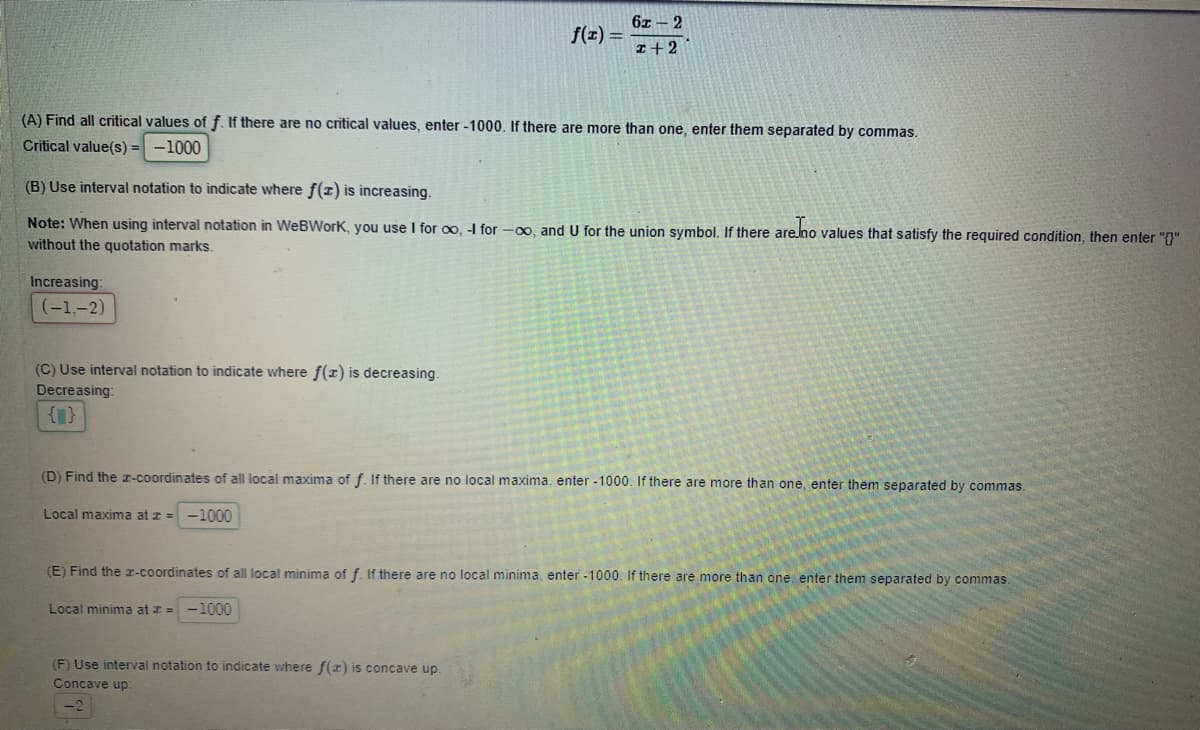Functions and Change: A Modeling Approach to College Algebra (MindTap Course List)
6th Edition
ISBN:9781337111348
Author:Bruce Crauder, Benny Evans, Alan Noell
Publisher:Bruce Crauder, Benny Evans, Alan Noell
Chapter2: Graphical And Tabular Analysis
Section2.4: Solving Nonlinear Equations
Problem 27E: Water Flea F. E Smith has reported on population growth of the water flea. In one experiment, he...
Related questions
Question

Transcribed Image Text:6z - 2
f(1) =
I+2
(A) Find all critical values of f. If there are no critical values, enter -1000, If there are more than one, enter them separated by commas.
Critical value(s) :
-1000
(B) Use interval notation to indicate where f(x) is increasing.
Note: When using interval notation in WeBWork, you use I for oo, -I for -00, and U for the union symbol. If there are.no values that satisfy the required condition, then enter "()"
without the quotation marks.
Increasing:
(-1,-2)
(C) Use interval notation to indicate where f(1) is decreasing.
Decreasing:
{1}
(D) Find the r-coordinates of all local maxima of f. If there are no local maxima, enter -1000. If there are more than one, enter them separated by commas.
Local maxima at z = -1000
(E) Find the x-coordinates of all local minima of f. If there are no local minima, enter -1000. If there are more than one enter them separated by commas
Local minima at z = -1000
(F) Use interval notation to indicate where f(z) is concave up
Concave up:
Expert Solution
This question has been solved!
Explore an expertly crafted, step-by-step solution for a thorough understanding of key concepts.
Step by step
Solved in 3 steps

Recommended textbooks for you

Functions and Change: A Modeling Approach to Coll…
Algebra
ISBN:
9781337111348
Author:
Bruce Crauder, Benny Evans, Alan Noell
Publisher:
Cengage Learning

Algebra & Trigonometry with Analytic Geometry
Algebra
ISBN:
9781133382119
Author:
Swokowski
Publisher:
Cengage

Glencoe Algebra 1, Student Edition, 9780079039897…
Algebra
ISBN:
9780079039897
Author:
Carter
Publisher:
McGraw Hill

Functions and Change: A Modeling Approach to Coll…
Algebra
ISBN:
9781337111348
Author:
Bruce Crauder, Benny Evans, Alan Noell
Publisher:
Cengage Learning

Algebra & Trigonometry with Analytic Geometry
Algebra
ISBN:
9781133382119
Author:
Swokowski
Publisher:
Cengage

Glencoe Algebra 1, Student Edition, 9780079039897…
Algebra
ISBN:
9780079039897
Author:
Carter
Publisher:
McGraw Hill